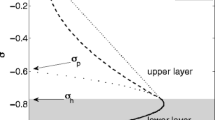Abstract
The treatment of diffusion due to the tidal current in the near-shore ocean, and the similitude in the hydraulic model experiment are studied.
In broad and shallow tidal bays and in the coastal seawaters near irregular boundaries, horizontal eddy-currents induced geometrically and turbulence caused by their cascading have predominant effect on dispersion of river and waste waters. These turbulent diffusion processes are similarly reproduced in the Froude models of turbulent resume, by adding the similitude for the self-similar structure of the spectral density of turbulence, or the eddy diffusivity. The similitude means to take the scale ratios of the time and the vertical length as the two-thirds power of the scale ratio of the horizontal length.
Similitudes are also derived for the system of the gravitational circulation, the stratification and the salt-mass transport in partially and well-mixed estuaries. Generally, the vertical eddy diffusivity must be exaggerated by a half power of the model distortion externally by some methods of agitation. When the tidal bay is broad and very shallow, the Rayleigh number and the Hansen number are small, and the effect of density current and stratification on the flushing is small. Instead the effect of local eddies, geometrically induced tidal residual circulations become predominant. In this special case, there is no need to satisfy the similitude for density difference and vertical shear effects on dispersion.
Similar content being viewed by others
References
Bailey, T.E., C.A. Mcculiough andC.G. Gunnerson (1966): Mixing and dispersion studies in San Francisco Bay. Proc. A.S.C.E.,91, No. SA 5, 23–45.
Bowden, K.F. (1965): Horizontal mixing in the sea due to a shearing current. J. Fluid Mech.,21, 83–95.
Chabert d'Hiéres, G. andJ.L. Hyacinthe (1967): Simulation of geophysical diffusion effect to scale. La Houille Blanche, No. 6, 659–666.
Fischer, H.B. andE.R. Holley (1971): Analysis of use of distorted hydraulic models for dispersion studies. Water Resource Res.,7, 46–51.
Fischer, H.B. (1972): Mass transport mechanisms in partially stratified estuaries. J. Fluid Mech.,53, 671–687.
Hansen, D.V. andM. Rattray (1966): New dimensions in estuary classification. Limnol. Oceanog.,11, 294–319.
Hansen, D.V. (1967): Salt balance and circulation in partially mixed estuaries.In Estuaries (ed.Lauff), AAAS Publ. 83, 45–51.
Harleman, D.R.F. (1965): The significance of longitudinal dispersion in the analysis of pollution in estuaries. Advance in Water Pollution Res. Proc. 2nd Conf., Pergamon press, New York, 279–290.
Hayami, S., H. Higuchi andK.H. Yoshida (1958): On the similitude of hydraulic models involving tidal motion. Disaster Prev. Res. Inst. Annuals of Kyoto Univ., No. 2, 83–95. (in Japanese)
Higuchi, H. (1963): Hydraulic model experiment involving tidal motion, Part I, II, III and IV, Disaster Prev. Res. Inst., Kyoto Univ. Bull., No. 59, 1–65.
Higuchi, H. andT. Sugimoto (1967): On the hydraulic model experiment on the diffusion due to the tidal current. Disaster Prev. Res. Inst. Annuals of Kyoto Univ., No. 10 B, 343–363. (in Japanese)
Horikawa, K. andK. Kajiura (1964): Experimental study on the tidal current in Tokyo Harbor. Coastal Engineering in Japan,3, 118–125. (in Japanese)
Inglis, C.C. andF.H. Allen (1957): The regime of the Thames estuary as affected by currents, salinities and river flow. Proc. Inst. Civ. Engrs.,7, 827–878.
Kajiura, K. (1964): On the bottom friction in an oscillatory current. Bull. Earthquake Res. Inst., Tokyo Univ.,42, 147–174.
Kent, R. (1960): Diffusion in sectionally homogeneous estuary. Proc. A.S.C.E.,85, No. SA 2, 15–48.
Keulegan, G.H. (1966): Model laws for coastal and estuarine models.In Estuary and Coastline Hydrodynamics (ed.Ippen), McGraw-Hill, New York, 691–710.
O'Connell, R.L. andC.M. Welter (1963): Hydraulic model tests of estuarial dispersion. Proc. A.S.C.E.,89, No. SA 1, 51–65.
Peice, W.A. andM.P. Kendrick (1963): Field and model investigation into the reason for siltation in the Mersey estuary. Proc. Inst. Civ. Engrs.,24, 473–517.
Rattray, M. andJ.H. Lincoln (1955): Operating characteristics of an oceanographic model of Puget Sound. Trans. Am. Geophys. Union.,36, 251–261.
Schlichting, H. (1968): Boundary Layer Theory. 6th ed., McGraw-Hill, New York.
Simmons, H.B. (1966): Tidal and salinity model practice.In Estuary and Coastline Hydrodynamics (ed.Ippen), McGraw-Hill, New York, 711–731.
Simmons, H.B. (1969): Use of models in resolving tidal problems. Proc. A.S.C.E.,95, No. HY 1, 125–145.
Author information
Authors and Affiliations
Rights and permissions
About this article
Cite this article
Sugimoto, T. Similitude of the hydraulic model experiment for tidal mixing. Journal of the Oceanographical Society of Japan 30, 260–270 (1974). https://doi.org/10.1007/BF02109669
Received:
Issue Date:
DOI: https://doi.org/10.1007/BF02109669




